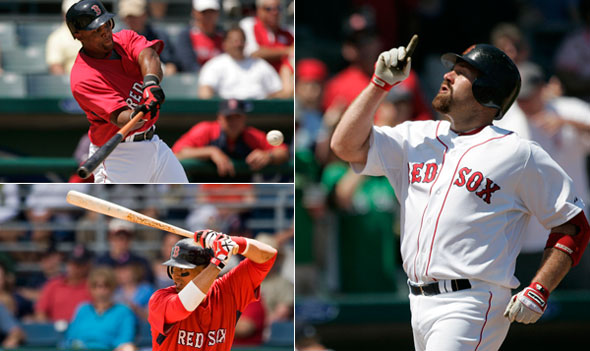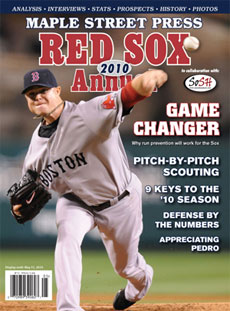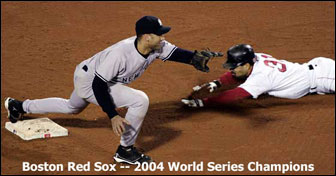Will There Be a Power Outage in Boston This Summer?

The 'O' in Sox Still Stands for Offense
BDD's exclusive excerpt of the Maple Street Press 2010 Red Sox Annual: Looks Can Be Deceiving: Despite the Outcry, the Boston Offense Should Remain Elite
By Steve Mastroyin
Much has been made of the Red Sox� strategy in the 2009�10 offseason. It�s all over the new media, it�s all over the old media. You can�t turn on sports radio or browse the Internet without knowing it. Defense, defense, defense.

|
From Theo Epstein�s late-September comments up through the moment the Red Sox inked renowned gloveman Adrian Beltre, it has been clear defense was going to the be the priority, unless a bat fell into Boston�s lap. Jason Bay and Matt Holliday did not take deals the Red Sox found attractive and the team moved on, making their free agent splash with starter John Lackey, arguably the top run-preventing talent on the market.
This strategy, so different from the popular perception of recent Red Sox teams, has a lot of people gnashing their teeth. Some don�t believe in the improvements and think that, despite spending money, the team will be worse. After all, the Red Sox made very few errors last year and gave up the second-fewest unearned runs in the league, so why improve the fielding? Well, there are reasons to believe that those numbers do not tell the whole story, which you can read about in this Annual. You can also read about the strength and depth of the 2010 pitching staff, perhaps the best the Red Sox have ever assembled.
But what about the offense? After all, while Jonathan Papelbon�s implosion provided an ugly exclamation point to the Red Sox� playoff exit, the real problem was a lineup completely stifled in the first two games of the ALDS. And going back to the 2008 season, we all remember how the offense struggled at times against the Tampa Bay Rays in the ALCS.
Since then, the Sox have subtracted Bay, one of their more potent bats, and added Mike Cameron, a solid two-way player but not a slugger of Bay�s caliber. Mike Lowell is losing his full-time job in favor of Beltre, a defensive wizard (ranking #2 among all players in UZR/150 last season), but one who put up a .683 OPS last season.
Thus, some argue that Theo has failed to address the fatal flaw of the Red Sox, or even made the offense worse. Others point to the improved defense and pitching, but will that be enough to overcome a weak offense? There is another, frequently overlooked possibility�that the 2010 offense will not actually be significantly weaker than it has been in recent years. Sound far-fetched? It�s not.
RUNS SCORED, RUNS ALLOWED, AND PYTHAGORAS
As a framework for this argument, let�s start with some hypothetical situations. One way to measure team quality is to look Runs Scored (RS), Runs Allowed (RA), and a metric calculated from these two: Pythagorean Winning Percentage. Some of those dismayed at the direction the team has taken have made dire predictions of an 85-win season for the 2010 Red Sox. Others have made the argument that with a break here or there the Sox could be so good on defense that they win 100 games. Barring catastrophe or divine intervention, the truth will lie somewhere in the middle. Let�s take a moment to look at some possible scenarios through the eyes of Pythagoras.
In 2009, the Red Sox scored 872 runs and gave up 736, which the Pythagorean method projects to a 93�69 record. The table below looks at the expected wins and losses based on some possible RS/RA scenarios for 2010.
It�s likely that the focus on improving the defense should at least get the Sox back to giving up runs at the same rate they did in 2008. If that happens, even if they lose 50 runs at the plate, they will still arrive at the same expected record�93 wins. Moreover, if the defensive metrics are to be believed, there is reason to think that the 2010 Red Sox should be as good or better than the 2007 Red Sox. If that�s the case then even losing 100 runs on offense, which is just about the worst case realistic scenario, the Sox can again expect 93 wins.
The 2008 Blue Jays are also listed in the table because their 610 runs allowed represents the lowest team runs allowed in the AL East in the 2000s. This seems like a good practical limit for how good the Red Sox could be if everything on the defensive side falls into place. We can see that if the Sox are that good at preventing runs (and there is a chance, however slight, that they will be), then it would take an almost inconceivable col-lapse on offense (or really bad luck) to prevent this team from winning 95 or more games.
CHANGES TO THE LINEUP
That last line may stir up some thought. The presumption that the offense will not collapse is radical compared to what you will hear on the airwaves or read in newsprint. And even among people who appreciate the changes on defense, the concern that the Sox offense is just not good enough to compete in the tough AL East is a prevailing thought. But, this was a team that was third in the league last year in runs scored. How much has really changed? What should we expect in 2010?
The biggest change, and the one everyone is talking about, is the replacement of Bay with Cameron. Bay swung an excellent bat in his time with the Red Sox. In 2008 he had the tough job of replacing Manny Ramirez and did that admirably in both the regular season and the playoffs. He followed that up in 2009 by posting a .267/.384/.537 (AVG/OBP/SLG) line good for a 134 OPS+ while leading the team in home runs with 36 and RBI with 119.
Looking at Batter Runs (BR), which uses linear weights to calculate a player�s level of offensive performance above average, Bay�s 2009 season was worth 33 runs. He will be replaced in the lineup with Mike Cameron. The projections from Pete Palmer on page 28 have Cameron hitting .246/.335/.454 with 22 home runs and accumulating five Batter Runs in 2010. That�s 28 runs lost at one outfield position. Whatever the Red Sox found on that MRI last July, it was enough for them to risk a significant hit to the offense.
The next subtraction from the lineup is Mike Lowell. While Lowell is still on the team as of this writing, it is a long shot that he will approach the 484 plate appearances that he amassed in 2009. Lowell was a good hitter in 2009, hitting .290/.337/.474, with a 106 OPS+, accumulating 7 BR. Furthermore, Lowell�s constant battles with injuries left the Red Sox moving Kevin Youkilis to third for 56 starts in 2009. At first base during these times was a rogue�s gallery including Mark Kotsay (-4 BR), Casey Kotchman (-6 BR), Jeff Bailey (-1 BR), Aaron Bates (1 BR), and Adam LaRoche (0 BR), as well as Victor Martinez (whose time at first base was worth 6 BR). Not all of this playing time was due to Lowell�s injuries, and of course the bench will play in 2010 as well, but it�s probably fair to say that Lowell�s time lost to injuries cost the Sox one Batter Run, bringing our total for Lowell to 6 BR.
Lowell will be replaced by Adrian Beltre. Beltre has a huge defensive reputation but hit just .265/.304/.379 (82 OPS+) in 2009. That is a pretty steep drop-off even from Lowell�s mediocre season. And while there is no doubt that he brings the leather, can the Red Sox really accept this type of bat from their third baseman?
With Beltre, there are a few things to keep in mind. First, he played much of last year with injuries that were not bad enough to keep him off the field for very long. Looking strictly at his OPS, 2009 was an outlier. In his previous three years in Seattle, he put up .792, .802, and .794. In fact his 2008 season, a .266/.327/.457 line for a 108 OPS+, looks remarkably similar to Mike Lowell�s 2009. How does Beltre�s 2008 equate to a higher OPS+ than Lowell�s 2009 even though his actual OPS was worse? Mostly due to the fact that Safeco is a poor hitter�s park, while Fenway is a good hitter�s park. In fact, when we take Safeco out of the picture, Adrian Beltre�s numbers look even better.
Over the past four years, Beltre has been 30 points better in OBP and 60 points better in slugging on the road. For this reason, our projection of a .268/.320/.444 line for Beltre in 2010 is not only reasonable, but may be conservative. But let�s go with the conservative projection, worth exactly 0 BR�that is a step down from what the Sox got at third base in 2009.
So, if one were to focus on the two subtractions to the offense only, it is easy to see why the Red Sox may be in trouble on offense. Losing 34 runs between two positions is not good. On the other hand, while it is a significant loss, it is not a collapse. Losing 34 runs on offense and improving the defense and pitching to a level of RA similar to the 2008 Red Sox (a very reasonable estimate) would yield 95 expected wins.
Beyond production from left field and third base, what many are ignoring is that the Sox have improved other areas. We can assume that this improvement has been overlooked largely because one player, Victor Martinez, was already in Boston at the close of the 2009 season, and because another, Marco Scutaro, is far from a big name acquisition. Still, these two players should represent significant gains over the players they will replace.
In 2009, the Red Sox made the deal to acquire Martinez by sending Justin Masterson and two minor leaguers to Cleve-land. With the inclusion of Nick Hagadone, it was a steep price to pay, but the Red Sox needed the help. Jason Varitek was continuing his decline and George Kottaras did not step up and perform. Since Martinez was not acquired until the end of July, the Red Sox suffered two-thirds of the season with below-average offense from the catchers. This year, they will have a full year of Martinez with Varitek as the backup.
In 2009, Varitek hit .209/.313/.390, good for an 80 OPS+ and -8 Batter Runs. Kottaras was worse, posting a .237/.308/.387 line for a 78 OPS+ and -2 BR. Martinez came in and immediately improved the team, hitting .336/.405/.507 (133 OPS+) with the Sox. Given his playing time split, that was good for 7 BR at catcher. This change was reflected immediately in the overall team numbers, as their scoring went from 4.84 runs per game in July to 5.89 in August. Martinez was not solely responsible for this change, but he was a big part. In all, Sox catchers combined for -3 BR in 2009.
In 2010, we expect Martinez to continue to hit well, with a .292/.366/.459 line. Even this conservative projection is a huge step up from the full-season line of Red Sox catchers in 2009. Varitek, in his reduced role, might expect a little bit of a bump. While a .224/.327/.393 line wouldn�t look great from a starter, it would likely put Varitek near the top of the list of backup catchers around the league. Furthermore, despite his general struggles, Tek actually hit lefties to a tune of an .807 OPS in 2009, and .821 over the past three years combined. With the addition of the versatile Martinez, this may be the year Terry Francona can use Varitek�s splits to the Sox� advantage. Both of the catchers together are predicted to combine for 13 batter runs, though a few of those will be with Martinez playing first or DH. In staying with our mantra of being conservative, we�ll say the catcher position will be worth 7 BR in 2010 on the assumption that Martinez spends about one-third of his time at positions other than catcher. This would represent an improvement of 10 runs over the production from the 2009 catching corps.
The other positive change is at shortstop. While Nick Green�s early season offensive heroics stick in people�s minds, he actually ended up with a horrific .236/.303/.366 line (71 OPS+) on the year, totaling -10 Batter Runs in just 350 plate appearances. The Red Sox did use a lot of other shortstops, though. Julio Lugo played regularly before his fielding sent him packing. He hit .284/.352/.367, for an 86 OPS+ and -1 BR. And Jed Lowrie never healed that wrist, posting a meager .147/.211/.265 line (21 OPS+), amassing -8 BR in just 76 plate appearances. Once again the Sox were bolstered by a mid-season acquisition, as Alex Gonzalez slugged well, posting a .284/.316/.453 line, good for a 95 OPS+ and another -1 BR. Add it all up, though, and Red Sox shortstops hit well below average, totaling -20 BR on the season.
The Red Sox shortstop in 2010 will be Marco Scutaro. Many were surprised when the Sox gave up a first-round draft pick in order to sign him, but looking at that ragtag collection of shortstops in 2009 one can see why they did. Although they could have re-signed Gonzalez, the Sox did not feel he would keep up his production at the plate or in the field and went for the slightly older Scutaro. This likely represents the largest risk the Red Sox took this offseason, as just two years ago Scutaro was a below average bat playing largely a utility role. That said, the Sox believe his success in 2009 was due to a sustainable mechanical change in his swing. Scutaro always had a great batting eye, hardly ever swinging at pitches out of the strike zone (better even than J.D. Drew). With the improved mechanics, he was able to make more solid contact when he did swing. The definable improvement makes it less likely that his age 33 season was a fluke, and at the very least he should be an improvement over the out-machines he is replacing. We project Scutaro hitting .278/.366/.391 in 2010, good for 5 Batter Runs, an improvement of 25 over the 2009 collection of shortstops.
In contrast to the runs lost in left field and at third, the Sox look to gain 35 runs at catcher and shortstop, effectively meaning the offense, given these projections, will not lose anything as a result of the lineup changes. While the Red Sox will likely be much worse at one lineup spot (Bay/Cameron), the falloff from Lowell to Beltre is not as huge as some believe, and significant improvements should occur at catcher and shortstop�two positions where production is not easy to find.
One perhaps hidden opportunity for the Red Sox is revealed by looking at the 2007 lineup. That lineup was extremely strong towards the right side of the defensive spectrum. DH, left field, first base, and third base were all well above average. That team�s big problems in terms of offense were at short and in center field. This makes it extremely hard to upgrade the offense in midseason, because there simply are not many players at those positions who are capable of run production and available on the trade market. Realistically, it is usually hard to find even an average center fielder or shortstop during the season.
Relative to past lineups, where most production came from the easiest positions to fill (DH and corners), the 2010 lineup looks much more flexible, with more production expected from the tougher end of the defensive spectrum and opportunity to improve at the other positions. Putting it simply, if David Ortiz, Mike Cameron, or Adrian Beltre are clearly not working out by midsummer, the Sox will have better opportunities to upgrade at the trade deadline, as corner infielders/outfielders and all-hit, no-glove DH types are exactly the kind of players often made available by teams that have fallen out of contention.
Another benefit that has not been talked about very much is the ability to give a shot to a younger, high-upside player. In this case, that player would be Jeremy Hermida, a one-time top prospect for the Florida Marlins. After the Marlins rushed his development, essentially skipping him from Double A to the bigs, Florida expected his second arbitration year to be too expensive for their limited budget and dealt him to the Red Sox for a pretty low price (the Sox and Hermida avoided arbitration with a one-year, $3.35 million deal). While it�s easy to focus on areas where Hermida has not succeeded to this point, he is entering his age-26 season�the front edge of a hitter�s peak. Also overlooked: from 2007�09, away from Florida�s pitcher-friendly confines, Hermida has hit an impressive .288/.371/.487 over 694 at bats. Moving to Friendly Fenway, Hermida profiles as a perfect �change-of-scenery� candidate. While many still are not high on Hermida, it�s worth noting that the last time the Sox had a guy like this�a highly regarded young player who had yet to blossom�on the roster, it was 2006. They were not able to work Carlos Pena into the lineup, and he departed for the clear skies of Tampa, where he hit 46 homers the following year.
Certainly there is some risk with the 2010 offense. This analysis only addresses the positions that have had a major change, and therefore assumes similar production in aggregate from returning players. When those players are included, we project the Sox to lose about ten runs without accounting for injuries. Even if the vagaries of injury and regression double that number, a loss of 20 runs is small compared to the rhetoric being tossed around after the Beltre signing. And in the end, the biggest gamble on offense may not be whether Beltre will recover to pre-2009 levels, but instead if Scutaro will manage to maintain his 2009 performance.
WHAT ABOUT THE PLAYOFFS?
Most would agree that unless the Rays make another big push the Sox are the favorites for at least the AL wild card. Whether you consider Red Sox fans spoiled or not, the fact is that when complaints about the strength of the offense arise, it usually has to do with the playoffs. Even in 2008 and 2009, in the regular season the Red Sox ranked in the top three in offense, but what sticks in the minds of the fans is the way the offense tanked in the postseason. Is there a substantial trend behind these playoff failures?
The chart shows the Red Sox� runs scored per game in the regular season and in the playoffs for every year Boston has made the playoffs since the 1994 strike.
There are several things we may learn from this chart. First, the obvious: The playoffs are a very small sample size and prone to much more variation. Second, at least in this small data set, the strength of the regular season offense has little bearing on the strength of the playoff offense. Regular season points form a relatively smooth line between the bounds of five and six runs per game, but the playoff data is a treacherous range of peaks and valleys. Of the three years the Red Sox had a �hot� offense during the playoffs, they won the World Series in two. In the third, that �hot� offense was mostly the product of one game, a 23�7 win over the Indians. With-out that game, the average drops to five runs.
At least in terms of offense, we can see that there is a complaint. The years in which the Sox fall short seem to fall squarely on team-wide slumps. The three lowest points on this graph are the three times the Sox have been swept out of the playoffs.
But what does that mean for 2010? A popular theory is that the best players perform the best in the playoffs. Another popular theory is that the Red Sox� struggles against �good� pitching lead directly to those playoff numbers, as the pitchers are generally better in the playoffs. If both of these things are true then the Sox bats may look good for 162 games but then fall flat on their faces again in the playoffs. This possibility is likely the chief worry in the minds of Sox fans, and maybe even the Sox front office.
MEDIOCRE OFFENSES AND PLAYOFF SUCCESS
Even if the Red Sox don�t look exactly like they have in the recent past, there is hope. Evidence shows that an elite offense is not required for a team to win in the playoffs. In the chart, team runs per game as a proportion of the league average is shown for every World Series team since the strike. We can see that in general, offenses that are below league average do not typically make it to the World Series. Only seven of the 30 teams meet that criterion. But we can also see that six of the World Series winners, as well as 13 of the 30 pennant winners, had offenses that were within 5% of league average. The better offense by this measure was 8�7 in the World Series.
In 2009, the Red Sox were 91 runs above average for the league. The 5% above league average level was 820 runs, which the Sox exceeded by 52 runs. Unless the changes to the offense lead to more than a 50 run drop, we can safely say the offensive performance will not necessarily kill the team�s playoff chances�if re-cent history is any indication.
It�s important to remember from the batting runs analysis that Boston�s offense is likely to remain strong in 2010. And perhaps the biggest thing for the optimists to note is that the last two times the Red Sox have dramatically improved their run prevention, they have won the World Series.
IN CONCLUSION
Any time you lose your best power hitter and do not directly replace him, there will be questions about the offense. And certainly, going into 2010, the Sox have questions. But, when taking an objective look instead of bemoaning the loss of Jason Bay�s 36 home runs and the addition of Mike Cameron�s strikeouts, the lineup doesn�t look as bad as many seem to believe. By our batter runs analysis, we have shown that the offense is not likely to fall off as much as the fearful talk radio and water cooler complaints have been suggesting. And according to Pythagoras, even with a loss of about 20 runs, the improved run-preventing Red Sox can expect a 96-win season even if they only get back to the 2008 level of defense and pitching.
If the offense regresses by a significant amount, the Sox have the ability to make up for it on the other side of the ball, and should be a playoff team in 2010. And once the playoffs start, all kinds of teams have won in the past, not just teams lucky enough to have a peaking Manny Ramirez and David Ortiz at the heart of the lineup.
Steve Mastroyin (Pawtucket, R.I.) is a lifelong Red Sox fan who thinks the biggest miracle of 2009 was hearing Glenn Ordway defend J.D. Drew. Surely world peace is right around the corner. The Maple Street Press 2010 Red Sox Annual is available online here







